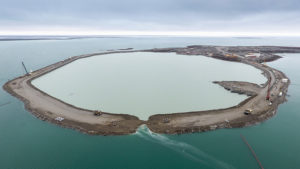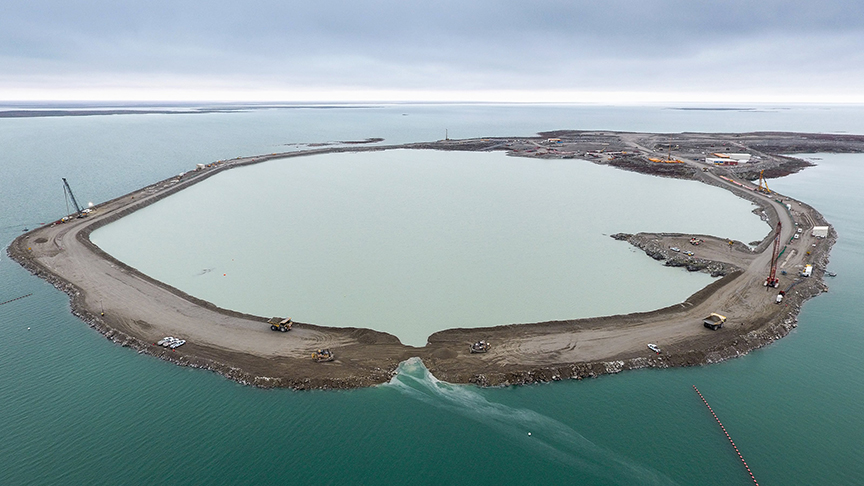Remote, rugged, and cold beyond belief — genuine Mesabi® radiators reduce downtime and perfect the art of diamond mining in Canada’s most demanding terrain.
Northwest Territories, Canada (north of Yellowknife) – Illuminated by 24-hour daylight during the summer and known for its unrelenting cold and darkness during the winter, Canadian diamond mines are anything but typical. To make it here, you need to be tougher than tough. And so does the equipment you rely upon.

In addition to frigid cold, Canada’s three highest-producing diamond mines are surrounded by expansive lakes and permafrost on all sides (Diavik and Ekati Mines are on Lac de Gras in the Northwest Territories and Gahcho Kue Mine is on Kennady Lake, also in the Northwest Territories). There are no towns within 150-300 miles of these operations, putting the mines on the very edge of isolation.
“One of our largest customers is the Diavik mine, which is just incredible,” said Jerry Jensen, L&M Radiator’s sales representative for Western Canada. “It started as an open pit mine, and later, after they could go as far as they could with the open pit operation, they created an underground mine under a lake. The mine is only accessible through ice roads during the winter because equipment must travel over lakes and permafrost.”
The ice road leading to Diavik Mine is exactly what it sounds like. The road, made of naturally occurring ice, only appears during the coldest few weeks of the year. Even during the warmer months, many mines cannot justify flying in equipment because of the significant cost, so any equipment the mine needs for an entire calendar year must be driven in within this brief timespan. In isolation as stark as this, preparedness is non-negotiable.
“These mines run 24 hours a day, 365 days a year. If a machine is down, and it can’t be easily repaired, it costs a lot of money,” said Jensen. “The key thing with these mines is preparedness, durability and always having the equipment and the backup parts that you need.”
This is precisely why all five of Canada’s active diamond mines rely on genuine Mesabi® radiators by L&M Radiator. Built to outlast the lifespan of multiple engines, keenly engineered for easy cleaning, and built with easily replaceable tubes to combat downtime due to damaged tubes, Mesabi® radiators are the driving force allowing access to the precious diamonds under Canada’s permafrost.
“I only get positive feedback from our Canadian clients,” said Jensen. “They trust Mesabi® because it doesn’t fail, it lasts the test of time, and it’s easy to repair – especially in these remote locations. So many of my remote customers love that they can just open the hatch, clear out the debris, replace tubes, and keep going. I wouldn’t say they’re bulletproof, but they’re close to it.”
Jensen notes that if any piece of a conventional (non-Mesabi®) radiator breaks, it is likely that the site would have to replace the entire unit, which could take up to a full day (or more). With a Mesabi® radiator, it is unlikely a site will be down for more than an hour or two while they replace a tube and continue operating.
Mesabi Drives Operations in the Earth’s Coldest Climates
Even for those who grew up in chilly environments, the kind of cold that enters Canada’s far north during the winter months is enough to knock someone right off their feet. If any temperature below freezing makes you want to lock yourself indoors for the winter, try -20°F or even -50°F.
“Even as a Canadian who grew up in the cold, it is incredibly cold up there,” said Jensen, who lives north of Calgary, Alberta. “On my first visit to the Northwest Territories, I learned quickly that -40°F to -50°F is absolutely no joke.”
This extreme cold poses challenges not only for the people working at the mining site but for the machines as well. The intense cold lends itself to issues such as snow or ice clogging the machines, wet conditions, and increased vibration due to the hard, icy surfaces.
“In the cold, everything works a lot harder,” added Jensen. “You’ve got to run a machine harder to get just as far as you would in a normal climate. So, every machine, from haul trucks, motor graders, dozers, and drills are more prone to breaking down. That’s one of the reasons why Mesabi radiators are becoming more and more popular in harsh environments. Our radiators really shine when everything else is failing.”
The Larger the Diamond, the Higher the Stakes
Though the path to these diamonds is tricky and even downright treacherous at times, it reaps hefty rewards. According to Jensen, the Diavik Mine alone has produced some of the largest diamonds in North America. This includes the Vega of the Arctic diamond. At 177.21 carats, it is the heaviest diamond ever discovered in North America.
“Canadian diamonds are becoming more popular because they’re environmentally and ethically sourced. They’re non-conflict diamonds,” said Jensen. “So any diamond stamped as a Canadian diamond is becoming more sought after than diamonds from other parts of the world.”
The growing demand for Canadian diamonds only raises the stakes for diamond mining operations in the region. In the face of the frigid cold and harsh conditions, it is necessary to be equipped with the best of the best to succeed year-round. That is why every one of Canada’s top diamond mines runs Mesabi radiators.
“A lot of our equipment will come built into machines at an OEM level. We are quite popular on Caterpillar® (CAT) and Komatsu drills because of the vibration, as well as dozers and graders,” said Jensen. “I’ve been seeing all throughout Northern Alberta and the Territories lots of replacements and retrofits of conventional coolers, too. They’re bringing in Mesabi radiators to increase durability.”
You’ll even find Mesabi radiators on the generators (typically CAT or Cummins generators), which provide electricity and heat for entire mining sites year-round, even when temperatures fall 40 or 50 degrees below zero. All throughout Alaska, the Northwest Territories, the Yukon, and Nunavut, Mesabi radiators keep these generators operating at peak performance in body-numbing cold. For this specific application, Jensen recommends a Mesabi V-Tube radiator with brass or copper tubes.
“When you’re working in an environment like this, I would absolutely recommend a V-Tube radiator with brass or copper tubes,” said Jensen. “Especially for drills. You want the highest capacity possible and minimal build-up of debris. Mesabi radiators are proven to achieve this high performance even in the most rugged environments.”
Where Everything Else Fails, Mesabi® Prevails: Experience the Mesabi® Difference
To learn more about the Mesabi V-Tube radiators bringing success to Canada’s diamond mines, click here.
To read stories similar to this one, visit the Mesabi Exchange at www.Mesabi.com.

